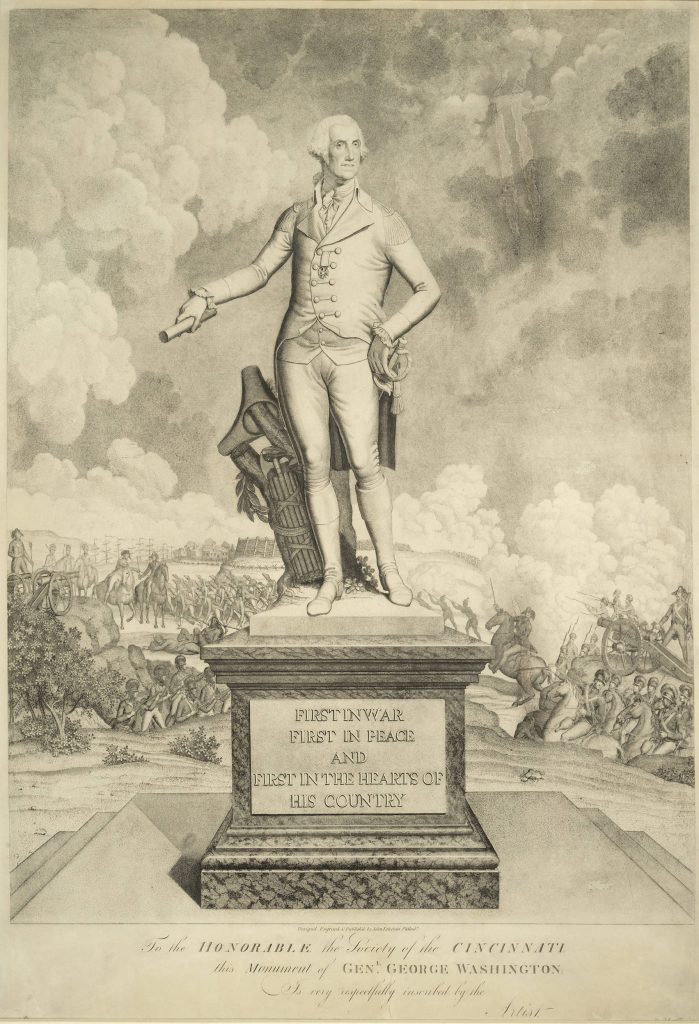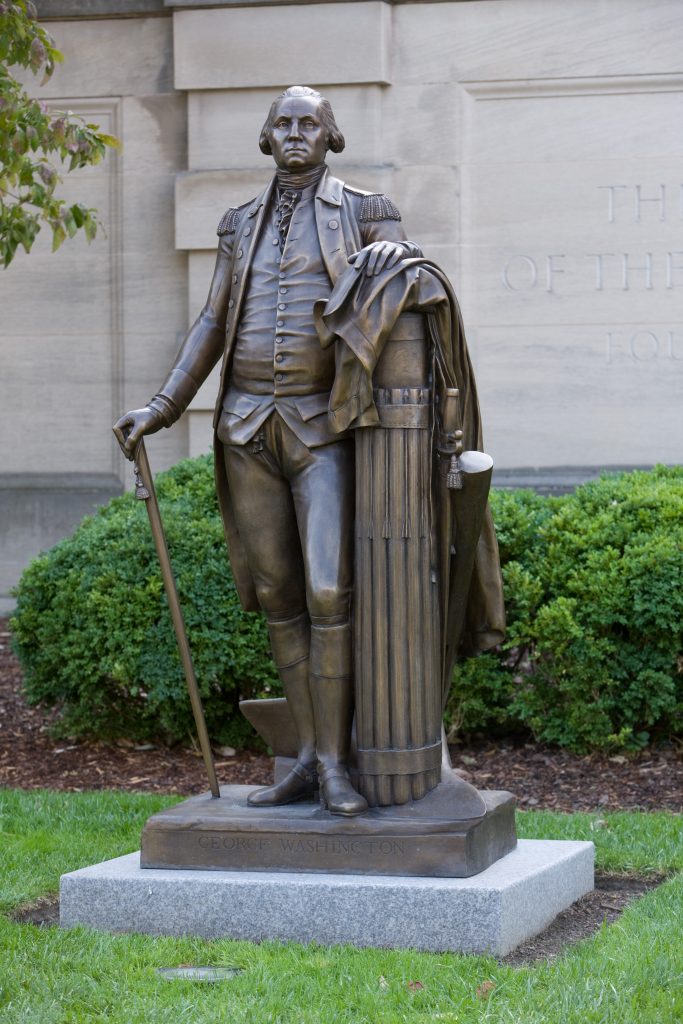Cynthia Burgett, Rachel Carson Middle School, Herndon, Virginia
DESIGN LEVEL: Middle School-High School
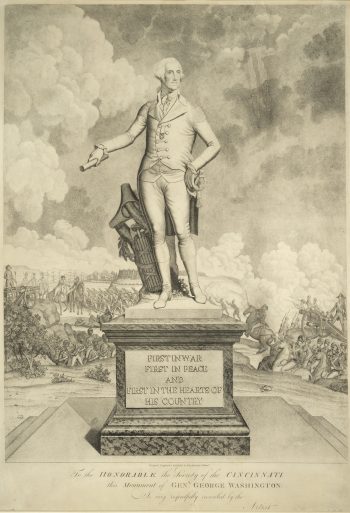
Overview
In creating our Constitution, the founders believed civic virtue would be essential to ensure the success of our new republic. This lesson plan explores the historic foundations of civic virtue in the United States by closely examining the role George Washington played as a role model of civic virtue. The goal is for students to realize that civic virtue remains a necessity if a lasting republic to succeed. Additionally, this lesson can be used as a precursor to a service learning project.
Objectives
Students will:
- Analyze the role of George Washington in setting the standard of civic virtue for a national leader.
- Identify the role of civic virtue in our Constitution.
- Identify and recognize current examples of civic virtue.
- Collaborate to develop a community project that demonstrates civic virtue.
Materials
- Eighteenth-Century Images of Cincinnatus, American Revolution Institute webpage.
- Saul Cornell, “Civic Virtue Means Citizen Obligations,” August 9, 2013, in Civic Virtue in Early America, produced by The Society of the Cincinnati, YouTube video, 6:01.
- “The Incomparable Malala Yousafzai,” September 19, 2015, The Ellen Show, YouTube video, 8:09.
- Journals of the Continental Congress, 1774-1789, Friday June 16, 1775, 92.
- George Washington, Letter to Martha Washington, Philadelphia, PA, June 18, 1775.
- Continental Congress to George Washington, Commission as Commander in Chief, Philadelphia, PA, June 19, 1775.
- Saul Cornell, “Newburgh Conspiracy and Civic Virtue,” August 9, 2013, in Civic Virtue in Early America, produced by The Society of the Cincinnati, YouTube video, 5:15.
- Continental Army orderly book kept by Capt. Ebenezer Smith of the 2nd Massachusetts Regiment, March-November 1783 at Newburgh and West Point, N.Y., pages 37-54, The Society of the Cincinnati.
- Library of Congress. “The American Revolution, 1763-1783.” Accessed January 11, 2018.
- George Washington, Circular Letter to the States, Newburgh, New York, June 8-20, 1783.
- United States Constitution, 1787.
- Saul Cornell, “Washington as the Modern Cincinnatus” August 9, 2013, in Civic Virtue and Early America, produced by The Society of the Cincinnati, YouTube video, 4:08.
- Sketch for the Society of the Cincinnati medal, Pierre-Charles L’Enfant, June 1783, The Society of the Cincinnati.
- First in war, first in peace, and first in the hearts of his country : to the honorable the Society of the Cincinnati : this monument of Genl. George Washington is very respectfully inscribed by the artist, John Eckstein, ca. 1806, The Society of the Cincinnati.
- George Washington mantel clock, Jean-Baptiste DuBuc, Paris ca. 1800-1810, Gift of David Gordon Sutton, Frank Taylor Sutton III, and Frank Taylor Sutton IV, 2001, The Society of the Cincinnati.
- Commemorative jug depicting the marquis de Lafayette and George Washington, Richard Hall & Son, ca. 1824, Gift of the Friends of the Boush-Tazewell House, Inc., 1991, The Society of the Cincinnati.
- George Washington statue cast from the original marble Jean-Antoine Houdon 1785 commission for the Virginia general assembly, Paul King Foundry, Johnston, RI under the direction of sculptor Robert Shure of Skylight Studios, Woburn, MA, 2008, The Society of the Cincinnati.
Recommended Time
Two 45-60 minute class periods (not including post-lesson service project).
Activity
Day 1:
Have students read “Eighteenth-century Depictions of Cincinnatus.”
Show students the video segment “Civic Virtue Means Citizen Obligations.”
Show students the video clip of Malala Yousafzai’s interview.
Explore the meaning of civic virtue as a class, and discuss why Malala is described as having civic virtue. Emphasize that civic virtue involves action not just thought.
Have students rotate through four of the eight stations to analyze a series of primary and secondary sources. Ask students to think about and answer the questions below for each source.
-
- When was this source created?
- What is the purpose of this source?
- Who is the audience for this source?
- How does this source relate to the idea of civic virtue?
- Why is this source important today?
At each table share opinions about the sources before moving to the next station. After all stations have been completed, conduct a whole class debrief on these resources.
STATION 1—George Washington’s response to his appointment to become commander-in-chief from Journals of the Continental Congress, 1774-1789, Friday June 16, 1775, page 92.
STATION 2—George Washington, Letter to Martha Washington, Philadelphia, PA, June 18, 1775.
STATION 3—Continental Congress to George Washington, Commission as Commander in Chief, Philadelphia, PA, June 19, 1775.
STATION 4—”Newburgh Conspiracy and Civic Virtue” video segment, and Continental Army orderly book (transcription at Library of Congress. “The American Revolution, 1763-1783.”), pages 37-54.
Day 2:
Show students the video segment “Washington as the Modern Cincinnatus.”
Have students rotate through the remaining four of the eight stations (those they did not visit on Day 1) to analyze a series of primary sources. Ask students to think about and answer the questions below for each source.
- When was this source created?
- What is the purpose of this source?
- Who is the audience for this source?
- How does this source relate to the idea of civic virtue?
- Why is this source important today?
At each table share opinions about the sources before moving to the next station. After all stations have been completed, conduct a whole class debrief on these resources.
STATION 5—George Washington, Circular Letter to the States, Newburgh, New York, June 8-20, 1783, pages 7-12 and 22-23.
STATION 6—United States Constitution (emphasis on Article II – Sections 1, 2 & 3).
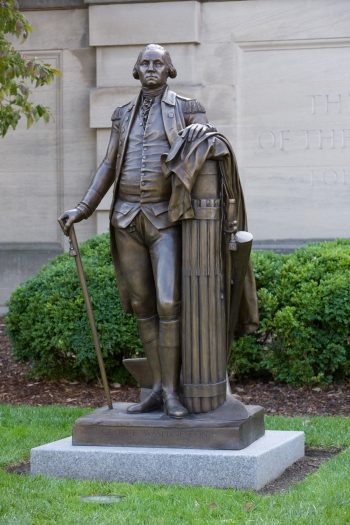 STATION 7—Sketch for the Society of the Cincinnati medal; First in war, first in peace, and first in the hearts of his country : to the honorable the Society of the Cincinnati : this monument of Genl. George Washington is very respectfully inscribed by the artist; George Washington mantel clock; Commemorative jug depicting the marquis de Lafayette and George Washington; George Washington statue.
STATION 7—Sketch for the Society of the Cincinnati medal; First in war, first in peace, and first in the hearts of his country : to the honorable the Society of the Cincinnati : this monument of Genl. George Washington is very respectfully inscribed by the artist; George Washington mantel clock; Commemorative jug depicting the marquis de Lafayette and George Washington; George Washington statue.
STATION 8—Rather than answering questions, brainstorm service learning projects to be conducted either in small groups or as a whole class.
Assessment
Compose a reflective essay for homework to synthesize the role civic virtue has contributed to the continued success of the American experiment in republican democracy, citing examples from notes taken from each of the eight stations as well as a “current events” example of a present-day citizen who demonstrates civic virtue.
Extension
As a class decide on a service learning project to be conducted either as a class, in small groups or individually in the community.
Standards Addressed
COMMON CORE: English Language Arts Standards—History/Social Studies—Grade 6-8
Historical Analysis and Skills Development: Reading, Writing, Speaking, Listening; Writing: Key Ideas and Details; Craft and Structure: Integration of Knowledge and Ideas
HISTORY AND SOCIAL SCIENCE STANDARDS OF LEARNING FOR VIRGINIA PUBLIC SCHOOLS—March 2015
Civics and Economics
CE.1 The student will demonstrate skills for historical thinking, geographical analysis, economic decision making, and responsible citizenship by
a) analyzing evidence from primary and secondary sources;
e) constructing informed, evidence-based arguments from multiple sources;
i) applying civic virtue and democratic principles to make collaborative decisions (examples include voting, volunteering, organizing a community group, attending a city or school board meeting);
j) defending conclusions orally and in writing to a wide range of audiences, using evidence from sources.
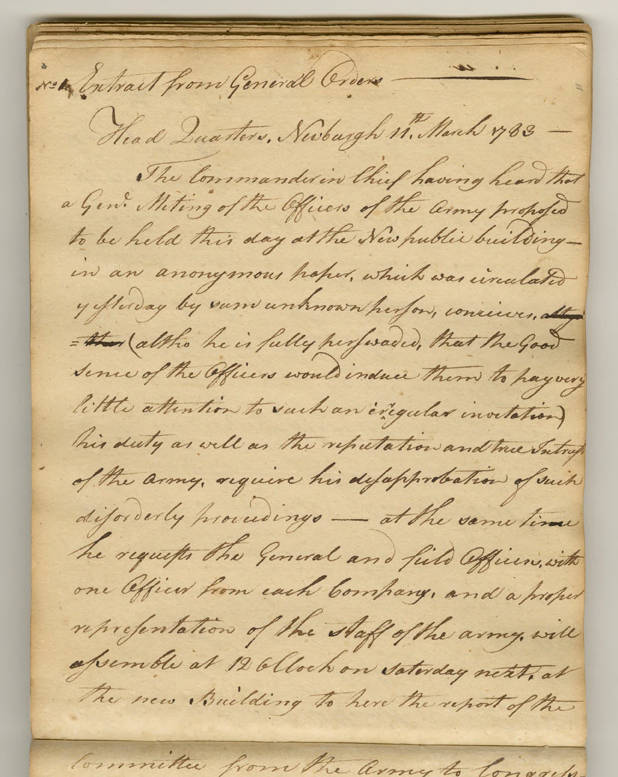
Continental Army orderly book kept by Capt. Ebenezer Smith of the 2nd Massachusetts Regiment
Newburgh and West Point, NY, March-November 1783The Society of the Cincinnati, The Robert Charles Lawrence Fergusson Collection
Includes regimental orders concerning the grievances of officers known as the "Newburgh Addresses," a transcript of Washington's address to the officers, a letter from a member of Congress and Henry Knox's resolution that the officers remain devoted to the cause of liberty for which they had paid "the Price of their Blood and eight years of service."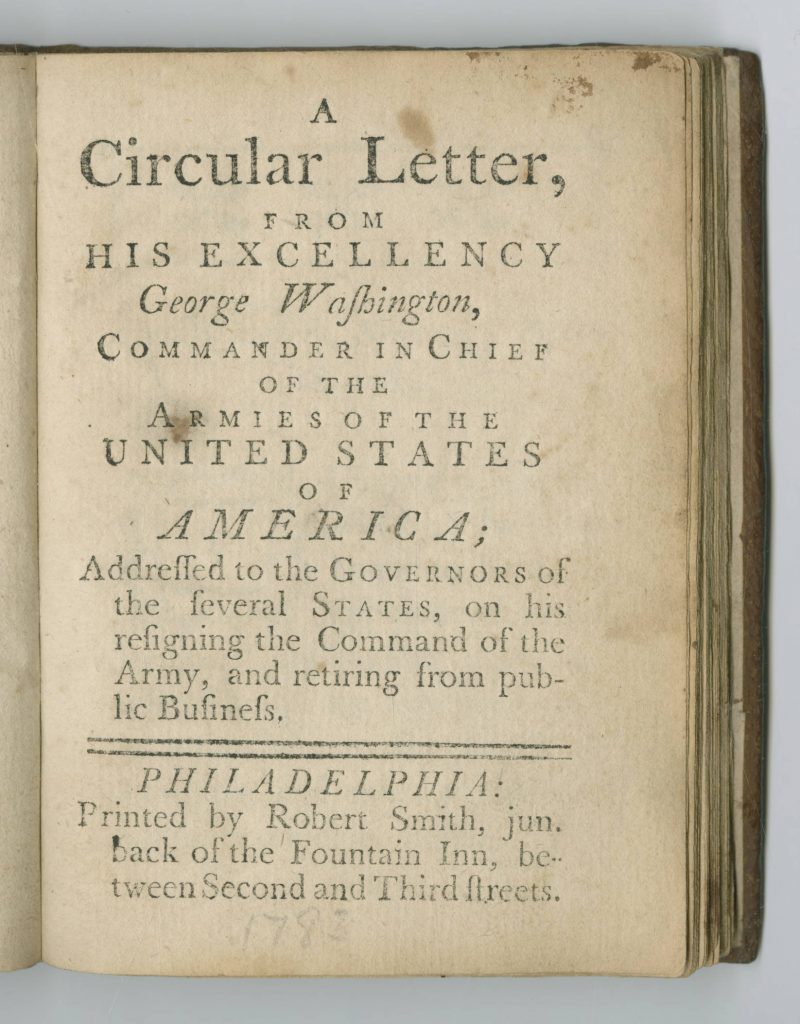
A circular letter, from His Excellency George Washington, commander in chief of the armies of the United States of America : addressed to the governors of the several states, on his resigning the command of the army, and retiring from public business
George Washington
Philadelphia: Robert Smith, 1783The Society of the Cincinnati, The Robert Charles Lawrence Fergusson Collection
At the end of the Revolutionary War, Washington issued a “circular letter” to the governors of the states, in which he reflected on the great achievement of independence and laid out his opinions on how the nation must proceed to keep this independence secure.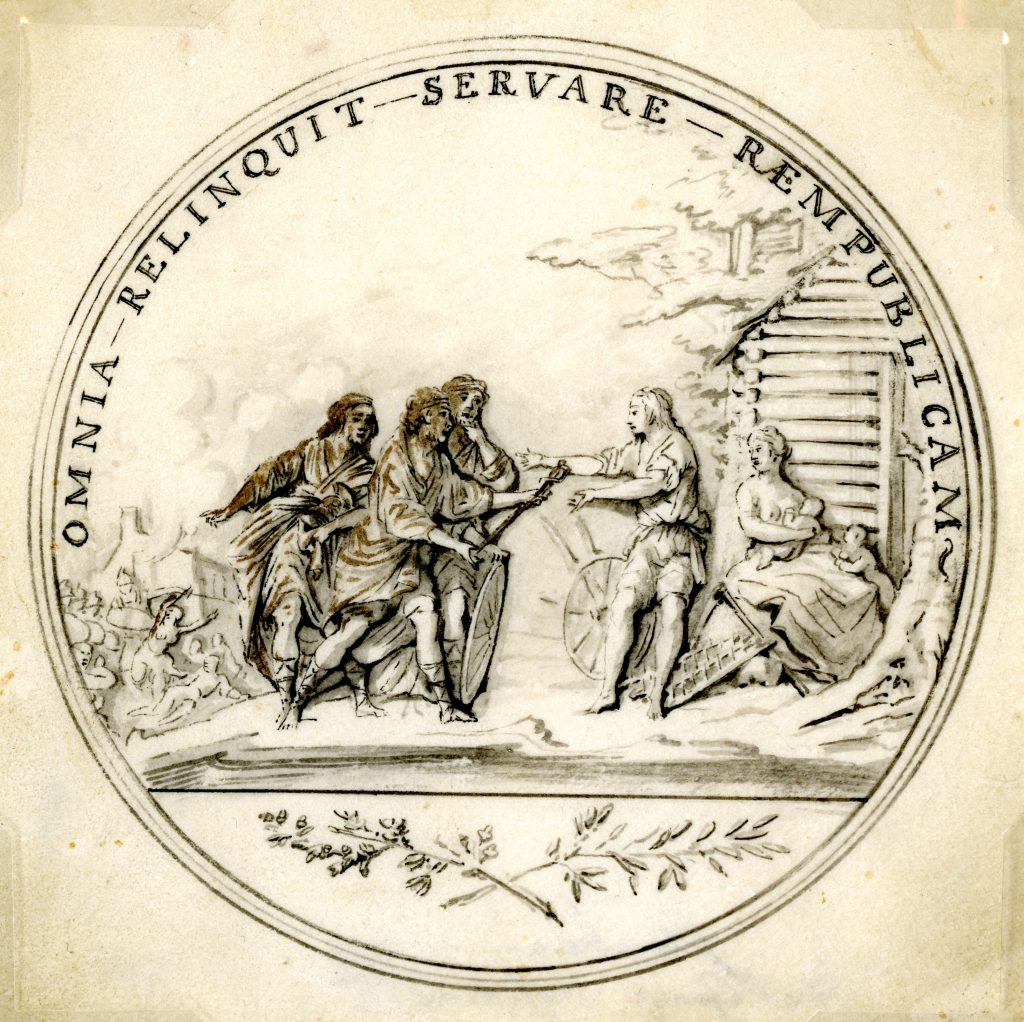
Sketch for the Society of the Cincinnati medal
Pierre-Charles L’Enfant
June 1783The Society of the Cincinnati Archives
At the request of the Society, Pierre-Charles L’Enfant, a French volunteer in the Continental Army Corps of Engineers, drew a design for a medal bearing imagery of the life of the fifth-century BC Roman hero Cincinnatus, from whom the Society takes its name. The obverse, shown here, depicts Cincinnatus receiving his sword from Roman senators as he leaves home to lead his country against its enemies.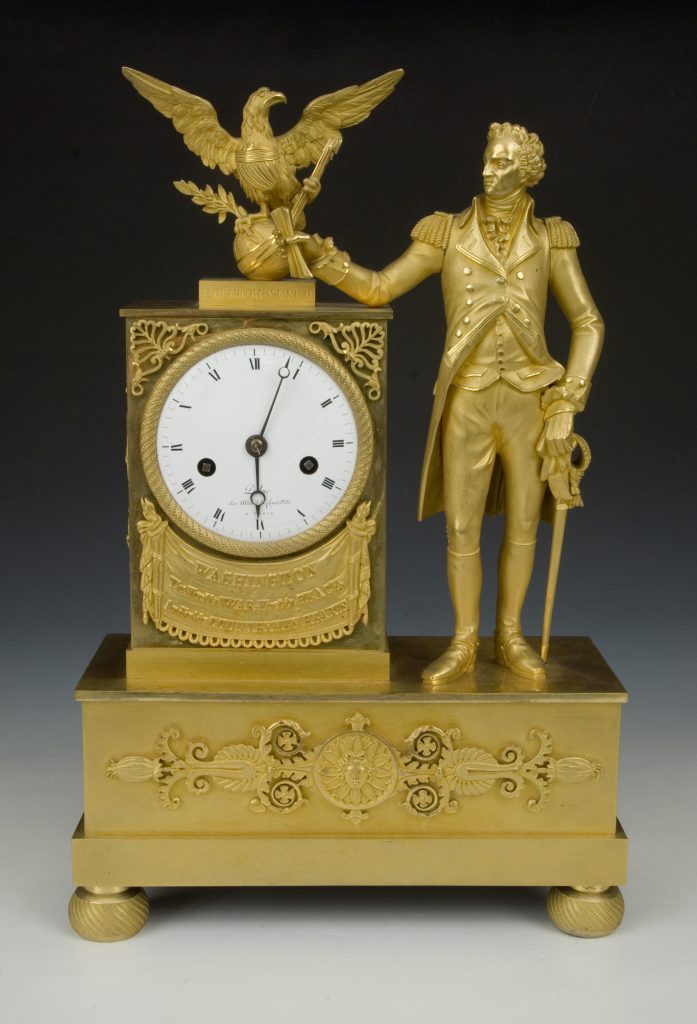
George Washington mantel clock
Jean-Baptiste DuBuc, Paris
ca. 1800-1810The Society of the Cincinnati, Gift of David Gordon Sutton, Frank Taylor Sutton III, and Frank Taylor Sutton IV, 2001
George Washington's death inspired artists and craftsmen in America, France and Great Britain to produce commemorative ceramics, medals, textiles and other objects memorializing the first president. This Neoclassical mantel clock, designed for the American market, features a standing figure of Washington in military uniform. The French clock's maker modeled the image of Washington after John Trumbull's 1792 portrait of the general before the battlefield at Trenton. The scroll held in Washington's right hand may allude to his resignation of his commission, an act comparable to Cincinnatus putting down his sword and returning to his plow.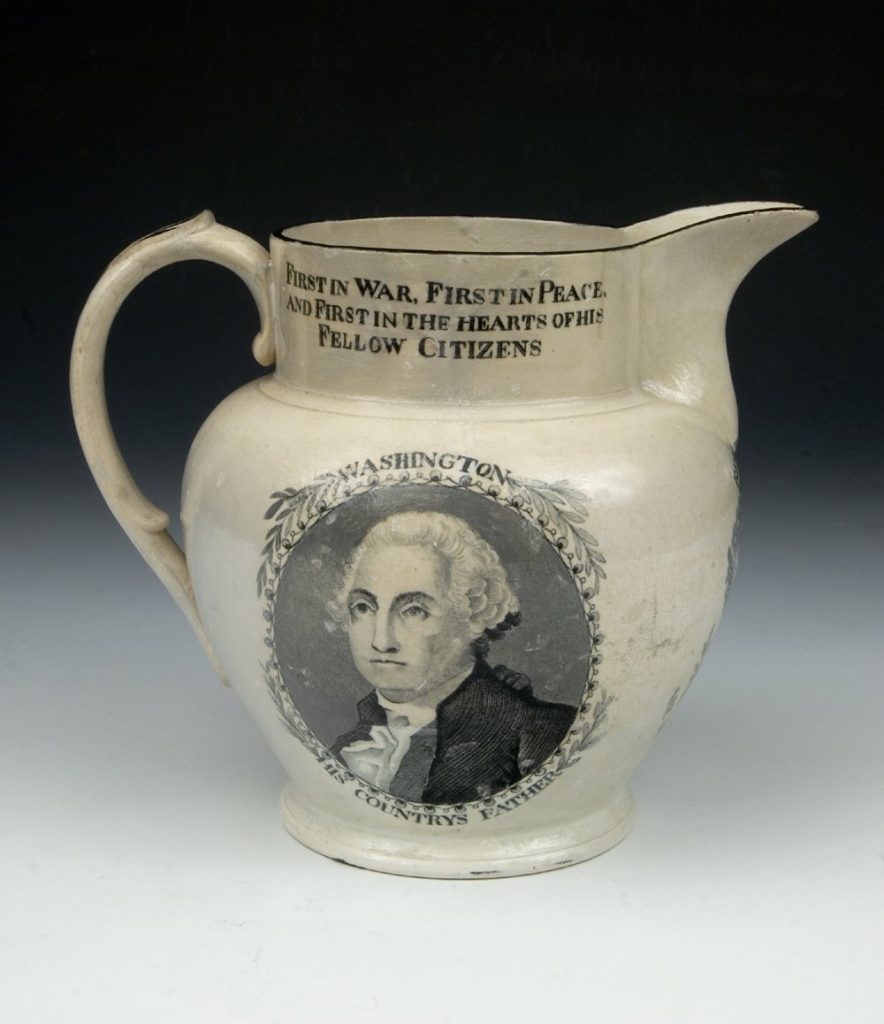
Jug commemorating the marquis de Lafayette's tourRichard Hall & Son, Staffordshire, England
ca.1824
Richard Hall & Son, Staffordshire, England
ca.1824The Society of the Cincinnati, gift of the Friends of the Boush-Tazewell House, Inc., 1991
One side bears a portrait of Lafayette (based on Ary Scheffer's full-length oil portrait painted by 1824) with the slogan "The Nation's Guest." The other side of the jug has a portrait of George Washington and related text. Made for export to the American market.


